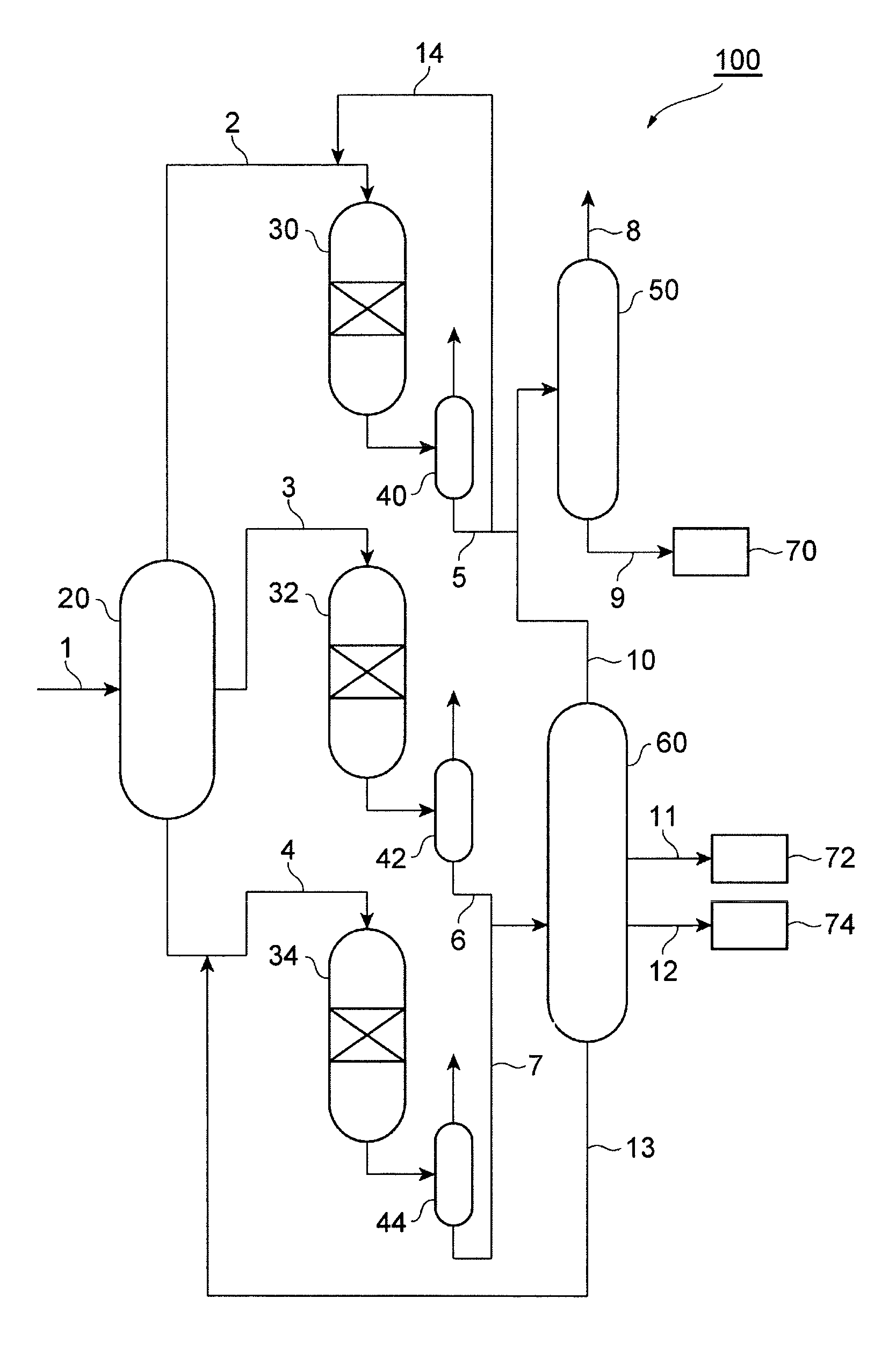Hydrogenation refining catalyst and method for producing a hydrocarbon oil
a hydrocarbon oil and catalyst technology, applied in the direction of hydrocarbon oil treatment products, physical/chemical process catalysts, metal/metal-oxide/metal-hydroxide catalysts, etc., can solve the problems of engine fuel consumption and engine fuel consumption, and achieve excellent cold flow properties, suppress cracking activity, and high hydro-isomerization activity
- Summary
- Abstract
- Description
- Claims
- Application Information
AI Technical Summary
Benefits of technology
Problems solved by technology
Method used
Image
Examples
example 1
Preparation of Hydrotreating Catalyst
[0126]Water was added to a composition containing 60% by mass of powdered silica zirconia (molar ratio of silica / zirconia (molar ratio of silica to zilconia): 7) and 40% by mass of powdered alumina and kneaded into a clay-like form, and starch was compounded therein as a molding additives at a proportion of 5% by mass based on the total mass of silica zirconia and alumina and further kneaded to prepare a kneaded mixture. This kneaded mixture was molded by extrusion molding into a cylinder with a diameter of about 1.5 mm and a length of about 3 mm. The obtained mold was dried at 120° C. for 3 hours and further calcined in air at 450° C. for 3 hours to obtain a catalyst support. As a result of measuring the content of a residue containing the starch-derived carbon atom contained in this catalyst support using the carbon / sulfur analyzer EMIA-920V manufactured by Horiba, Ltd., it was 1.1% by mass based on the mass of the catalyst support.
[0127]This c...
example 2
Preparation of Hydrotreating Catalyst
[0134]A hydrotreating catalyst was obtained in the same way as in Example 1 except that the calcination time at 500° C. was set to 0.5 hour in the calcination of the catalyst precursor. The content of the carbonaceous substance in the hydrotreating catalyst was 0.3% by mass in terms of the carbon atom.
[0135]
[0136]Hydrotreating of the FT synthetic oil-derived middle distillate was performed in the same way as in Example 1 using the hydrotreating catalyst obtained above. A reaction temperature at which the C18 isomer ratio became 85% was 338° C., and the yield of the gas oil fraction was 44% by mass. In addition, neither olefins nor oxygen-containing compounds were substantially contained in the liquid hydrocarbons separated by the gas liquid separator. The results are shown in Table 1.
example 3
Preparation of Hydrotreating Catalyst
[0137]A catalyst precursor was prepared in the same way as in Example 1. This catalyst precursor was charged into a heating furnace, heated to 300° C., then heated at a heating rate of 10° C. / h between 300 and 400° C., and then calcined at 480° C. for 0.5 hour to obtain a hydrotreating catalyst. The content of the carbonaceous substance in the hydrotreating catalyst was 0.8% by mass in tetras of the carbon atom.
[0138]
[0139]Hydrotreating of the FT synthetic oil-derived middle distillate was performed in the same way as in Example 1 using the hydrotreating catalyst obtained above. A reaction temperature at which the C18 isomer ratio became 85% was 339° C., and the yield of the gas oil fraction was 44% by mass. In addition, neither olefins nor oxygen-containing compounds were substantially contained in the liquid hydrocarbons separated by the gas liquid separator. The results are shown in Table 1.
PUM
| Property | Measurement | Unit |
|---|---|---|
| boiling point | aaaaa | aaaaa |
| boiling point | aaaaa | aaaaa |
| temperature | aaaaa | aaaaa |
Abstract
Description
Claims
Application Information
 Login to View More
Login to View More - R&D
- Intellectual Property
- Life Sciences
- Materials
- Tech Scout
- Unparalleled Data Quality
- Higher Quality Content
- 60% Fewer Hallucinations
Browse by: Latest US Patents, China's latest patents, Technical Efficacy Thesaurus, Application Domain, Technology Topic, Popular Technical Reports.
© 2025 PatSnap. All rights reserved.Legal|Privacy policy|Modern Slavery Act Transparency Statement|Sitemap|About US| Contact US: help@patsnap.com


